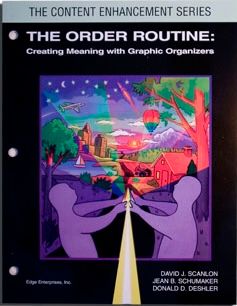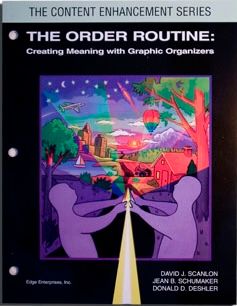The ORDER Routine (Printed Manual)
$31.00
Newly Added!
A Routine for Explaining Text, Topics and Details
Save this product for later
The ORDER Routine (Printed Manual)
Product Details
Teachers use the ORDER Routine to organize and make sense of information visually. Students think about what they have just learned or read, try to understand how it all fits together, look for any missing information or errors in their notes, and try to fit it all together to create their own graphic organizer.
Every year, there is more information to be taught and less time to teach it. How can students even begin to see the forest through all the trees? One way to help them see the relationships among the pieces of information is to teach them to find those relationships.
To do this, teachers can use the ORDER Routine to teach students to recognize four basic types of relationships (e.g., compare and contrast, problem-solution) and to draw pictures of those relationships. At first, the teacher guides the discussion as students suggest ways to depict the relationships among pieces of information. Later, as students understand the process and become proficient at the higher order thinking skills required, the teacher can turn the process over to the students so that they are either working with each other or independently to depict the information. Since the information in their depictions will represent some of the most important information in the course, students can use their pictures as they study for tests and write essays. This instructor’s manual provides step-by-step instructions on how to introduce this routine to students and transfer use of the process over time to the students.
Please note that professional development, coaching, and infrastructure support are essential components to effective implementation of SIM instructional tools and interventions. It is highly recommended that you work with a SIM professional developer. SIM Professional Development is tailored to student needs. Fill out this form to tell us about your situation and to request professional development.
You May Also Like
Newly Added!

The Framing Routine (Printed Manual)
The Framing Routine (Printed Manual)
A Routine for Explaining Text, Topics, and Details
$31.00
Newly Added!

The Clarifying Routine (Printed Manual)
The Clarifying Routine (Printed Manual)
A Routine for Explaining Text, Topics, and Details
$31.00
Newly Added!

The Framing Routine (PDF Download)
The Framing Routine (PDF Download)
A Routine for Explaining Text, Topics, and Details
$31.00
Newly Added!

The ORDER Routine (PDF Download)
The ORDER Routine (PDF Download)
A Routine for Explaining Text, Topics and Details
$31.00
Display prices in:USD
